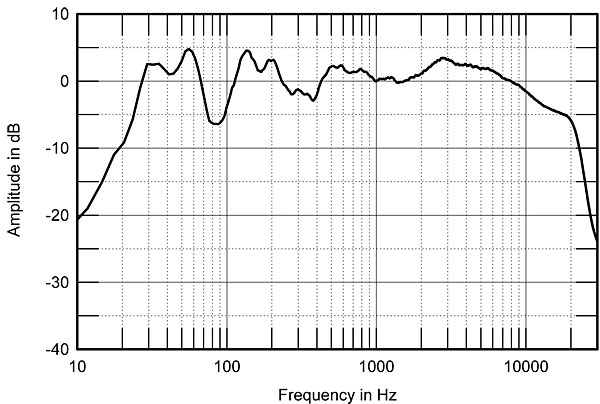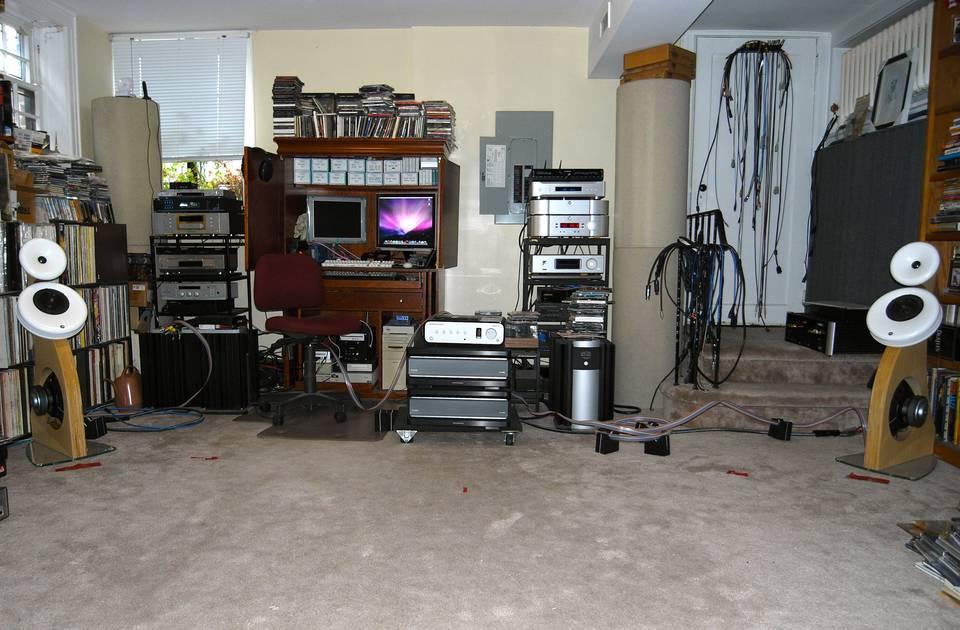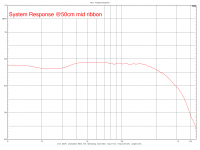Here is Atkinson's story fo playing with sideways dipole of Gradient Helsinki 1.5. Pretty tricky...
Now thats an interesting story about getting good dipole bass extensions using side wall reinforcement:


......pictures of my own attempt. It looks a lot like the totem of tone but with cheaper units and electronics.
best regards, Erik
Great looking speakers there Eric - congratulations.
Talking about the subject of floor and wall reinforcement.
for our 3x5m hobby/office room I am considering some dipole CD speakers as well - but I would like to keep the speakers out of the way: kids are running around, we want the workbenches and closets to be acessible, etc. So I though about hanging the speakers on the 2.5m high ceiling.
I thought about placing the woofers, going up to maybe 200Hz in the corners, to have reinforcement of both ceiling and walls. The layout of these would look like the picture in the attachment. What do you think? I am not yet sure what I would use for mid and high frequencies, so I put in the NEO10s and AMTs again, which are very nice units indeed.
I want to experiment with tilting the mid/hi units. I drew a chair in there, which is the position where we are sitting doing our office work, but it would be great if the "sweet spot" would be larger, as during hobbying we walk around the room, do some work on the floor, etc.
Best regards!
Erik
for our 3x5m hobby/office room I am considering some dipole CD speakers as well - but I would like to keep the speakers out of the way: kids are running around, we want the workbenches and closets to be acessible, etc. So I though about hanging the speakers on the 2.5m high ceiling.
I thought about placing the woofers, going up to maybe 200Hz in the corners, to have reinforcement of both ceiling and walls. The layout of these would look like the picture in the attachment. What do you think? I am not yet sure what I would use for mid and high frequencies, so I put in the NEO10s and AMTs again, which are very nice units indeed.
I want to experiment with tilting the mid/hi units. I drew a chair in there, which is the position where we are sitting doing our office work, but it would be great if the "sweet spot" would be larger, as during hobbying we walk around the room, do some work on the floor, etc.
Best regards!
Erik
Attachments
OT, but the thought had occurred to me to try widebands back to back. Are your mids and tweets in sealed boxes?I'm pleased to confirm your original suggestion works & works well in real life
The mid in the rotatable 'box' is dipole too.OT, but the thought had occurred to me to try widebands back to back. Are your mids and tweets in sealed boxes?
That's where you are wrong. The REAL reason for the speaker was stereo performance. You have excellent stereo image in the whole of the shaded area in the 2nd pic. ... and in fact a convincing illusion outside the area tooThank you guys for explaining this. I see one caveat, because of lack of direct sound, stereo imaging at "spot" suffers or is even lost!
I'm trying to find a HFN&RR article that Gareth Millward wrote about the work and theory behind this. The 'dipole in room' stuff was an added bonus
Like the 'dipole in room' stuff, we observed the phenomena first, and then developed the theory that allowed us to refine it later
I told you Option 1 was heretical on many fronts..
Two back to back, I take it it isn't a sealed box?The mid in the rotatable 'box' is dipole too.
I recall Charlie telling me he has listened to his dipoles well off-axis when I said I do so with mine and suspect I like the reflectionsI told you Option 1 was heretical on many fronts..
In Option 1, the dipole goes down to 35Hz. There are very few recordings that require power & extension below that but we wanted the lower frequency limit to begin with a '2'.
To extend LF to 25Hz, the whole back of the 'baffle' is a 90ltre reflex with its own 150W amp. We argued over this cos the omni sub changes the stereo perspectives and in the end put a switch so it could be OFF. That last octave cost loadsa $$$, size, space & units. We found very few music recordings (mainly organs) where the timbre changed when you turned the switch ON .. as it should be with true 35Hz cutooff on the dipole.
But on chamber music, especially recorded with my microphone and the Sony PCM-F1, the cello seeemed to move as the cellist played down the scale so most of the time, I preferred the sub OFF.
There's stuff like Mike Skeet's Garage Door where the sub is certainly worthwhile ... though on Option 1, even that is a demonstration of stereo & realism rather than head-banging bass.
These days, with home theatre, I'd expect more recordings where the sub is noticeable ... but I wouldn't call these 'music'.
To extend LF to 25Hz, the whole back of the 'baffle' is a 90ltre reflex with its own 150W amp. We argued over this cos the omni sub changes the stereo perspectives and in the end put a switch so it could be OFF. That last octave cost loadsa $$$, size, space & units. We found very few music recordings (mainly organs) where the timbre changed when you turned the switch ON .. as it should be with true 35Hz cutooff on the dipole.
But on chamber music, especially recorded with my microphone and the Sony PCM-F1, the cello seeemed to move as the cellist played down the scale so most of the time, I preferred the sub OFF.
There's stuff like Mike Skeet's Garage Door where the sub is certainly worthwhile ... though on Option 1, even that is a demonstration of stereo & realism rather than head-banging bass.
These days, with home theatre, I'd expect more recordings where the sub is noticeable ... but I wouldn't call these 'music'.
Thanks for this Erik. I like Gerrit's & your designs though of course I will challenge your use of no baffle3 way Totem of tone (+ sealed subwoofer) – well documented DIY project.
The Totem of Tone, an active 3-way dipole and active subwoofer
....
Therefore, there is recent effort in achieving equal radiation and some excellent results, which were probably not possible 30 years ago.
Two pictures of my own attempt. It looks a lot like the totem of tone but with cheaper units and electronics.
I'm trying to work out how Gerrit does his response curves. Does he have an anechoic? I suspect he does a lot of smoothing
I believe you & Gerrit use the MiniDSP. Can these do arbitrary IIRs? ie where you can specify any number of feedforward & feedback coeffs.
Last edited:
I managed to find the user manual for the Warfedale Option 1's
http://allsystemstech.ca/main/wp-content/uploads/2018/01/Brochure-Wharedale-OptionOne.pdf
Keith
http://allsystemstech.ca/main/wp-content/uploads/2018/01/Brochure-Wharedale-OptionOne.pdf
Keith
Thanks for this Keith.I managed to find the user manual for the Wharfedale Option 1's
http://allsystemstech.ca/main/wp-content/uploads/2018/01/Brochure-Wharedale-OptionOne.pdf
Gentlemen, this is only slightly Marketing BS. eg the descriptions of what you hear are pukka.
I'm still looking for the HFN & RR article wid da obfuscating maths
Gentlemen, this is only slightly Marketing BS. eg the descriptions of what you hear are pukka.
Thanks for this Erik. I like Gerrit's & your designs though of course I will challenge your use of no baffle
I'm trying to work out how Gerrit does his response curves. Does he have an anechoic? I suspect he does a lot of smoothing
I believe you & Gerrit use the MiniDSP. Can these do arbitrary IIRs? ie where you can specify any number of feedforward & feedback coeffs.
The response curves are measured quasi-anechoic without any smoothing applied
Here's the response measured with 96kHz sample rate to show how the ribbon drops off above 20kHz:

The step at 2.5kHz is because the response is measured mid-ribbon @ 50cm, at a greater distance the curve is flat. Again, no smoothing applied (length= 4.07ms ~ 250Hz resolution).
I use a Hypex DLCP for the filtering, asymmetric shelves are used to correct for the dipole drop off and create part of the high-pass filter, see the thread for details.
Is the software to do your quasi-anechoic in the Hypex DLCP development kit? Or do you use a dedicated programme?The response curves are measured quasi-anechoic without any smoothing appliedThe resolution is of course limited by the measurement length. The parameters are shown in the legend with the measurements.
...
I use a Hypex DLCP for the filtering, asymmetric shelves are used to correct for the dipole drop off and create part of the high-pass filter, see the thread for details.
BTW, VERY impressive KEFplots (their CDS or waterfalls) on that ribbon.
Is the software to do your quasi-anechoic in the Hypex DLCP development kit? Or do you use a dedicated programme?
BTW, VERY impressive KEFplots (their CDS or waterfalls) on that ribbon.
Thanks
I used the Audiomatica Clio 11 measurement system and imported the results in the Hypex software to design the filters. The Hypex software is only geared towards filter design and does not have functions required for driver design. During the development of the ribbon I used frequency response, distortion analysis (to 5th harmonic), CSD and of course directivity to evaluate the performance. Because of the required dipole correction is is very important to measure the distortion of a driver with the correction applied.
One area that has been neglected (in my opinion) is what is happening to the rear of the loudspeaker. In an open baffle or dipole speaker, there is sound emanating from the rear that ultimately reaches the listener via the room and this is just as important as what is coming out of the front of the loudspeaker. So when I talk about a "full range dipole" loudspeaker I mean to emphasize that the front and rear radiation pattern should be as similar as possible over all frequencies.
It's been 6 months on, so I thought I would provide an update...
The hard winter and cross country move has slowed down progress, but I seem to be coming back up to speed now.
I am still eagerly but slowly pursuing my initial 20-20k dipole* goal. I have decided to try and create a system for which the bass section below 150Hz or so can be dipole or monopole. I seem to have most of the puzzle pieces in place for that now and I am starting to build.
The system will be 3-way (at least I hope so). A "bass" section will cover 30-150Hz, with the option of using dipole (2x Alpha 15A) or monopole (2x 12") subwoofers. Above 150Hz will be a "nude dipole" MT section using drivers suspended by wires within a wooden frame (I have done this before with good results). The "M" driver will be a 15" (not the Alpha 15A!) that is well suited for the 200-2k Hz band. The "T" driver will likely be a back-to-back tweeter arrangement that I came up with in 2017, with a fallback being the B&G Neo3PDR. I plan to (try to) align the acoustic centers of the MT section so that as much as possible the front and rear radiation pattern is similar. Judging by measurements that I have made on these drivers in the past, this goal will be possible.
* Regarding the monopole woofers: I have always wanted a test system that could be made up with either monopole bass or dipole bass. The monopole bass to dipole midrange transition will create a frequency region with a cardiod pattern, but it is the general "feel" and "impact" at the low frequency end of the spectrum that I hope to compare between dipole and monopole. The particular dipole and monopole options that I have at my disposal will have about the same low frequency cutoff, so it should make for an interesting comparison.
...as much as possible the front and rear radiation pattern is similar....
There's the "baby" and then there's the "bath water". You need to ask what is nice about unboxed speakers that emphasize the ambience and what are their shortcomings.
Skipping right ahead... you want the back sound to bounce around and interact with the front only in ways you like. Some time ago, I mounted a 15-inch, 21 Hz driver on a large panel that I hid under a table. As in the thread about sequestering the rear wave, you don't want to fight physics but you do want to avoid a box; therefore you make the rear wave messy as it comes around the front of the driver. The path between front and back was very irregular - it is heterogeneity that leads to SQ, not rigid engineering-like uniformity which always seems to have a meretricious appeal in this forum.
B.
20 to 20K goal?
Good evening Charlie....
Trying to get a grip on what your goal really is.... 20-20K open baffle is a simple design exercise... as with the Iron Law, the compromise between how big, how efficient and how loud do you need to play. It is a 20 minute design issue. The real variable is how much money you can justify spending!
Yes 3 way.... best to shoot for 90-ish db/watt half space efficiency flat to 30 Hz. Forget mono-pole bass.... so many have been built, but just are not musical, with a couple of very large and expensive exceptions.
As with all speakers, the midrange is what will set the design apart from also-ran(s). This is where the true design challenge lies (rests).
Know you thirst for a challenge and to learn along the way. So, what are your deal breakers?
Good evening Charlie....
Trying to get a grip on what your goal really is.... 20-20K open baffle is a simple design exercise... as with the Iron Law, the compromise between how big, how efficient and how loud do you need to play. It is a 20 minute design issue. The real variable is how much money you can justify spending!
Yes 3 way.... best to shoot for 90-ish db/watt half space efficiency flat to 30 Hz. Forget mono-pole bass.... so many have been built, but just are not musical, with a couple of very large and expensive exceptions.
As with all speakers, the midrange is what will set the design apart from also-ran(s). This is where the true design challenge lies (rests).
Know you thirst for a challenge and to learn along the way. So, what are your deal breakers?
- Home
- Loudspeakers
- Multi-Way
- In Pursuit of a 20-20k Dipole Loudspeaker
